He was generous with his family and supported them his whole life. Pretty cool. He was also superstitious and believed in omens, which is good to know. As I look at his images I'll be looking for clues in his work.
He studied at the Academy of Art in Vienna and had some kickin' teachers who encouraged him to develop his own style. He had one true love, Alma Mahler. It was a tumultuous relationship. His painting, "Bride of the Wind" (Tempest) was an expression of their relationship. Let's see it then...
Their relationship didn't last more than a few years.
Oskar struggled in the beginning. His use of color was timid and his style was childlike.
Children Playing 1909
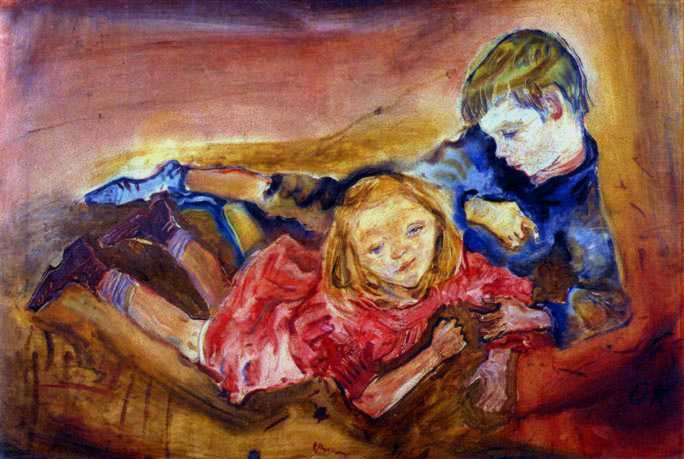
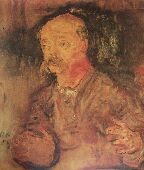
And this portrait of
Peter Attenberg in 1909
Girl Hands Raised, 1908
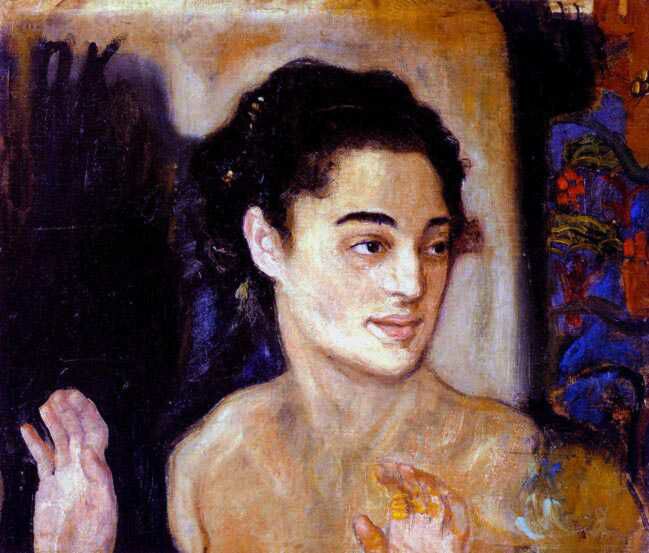
As I look through his body of work I'm impressed. He had skill, yes. And he was an Expressionist, yes. But he also had a natural way of approaching his subjects that encompassed the human experience too. There was sadness, yes. There was passion, yes. But there was also a sense of humor that bubbled up through his artistic commentary of the idiocy of mankind that is thought provoking.
Landscape in Dolomite's 1913
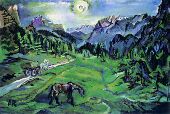
Stockholm Harbour 1917
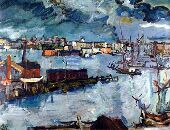
Dresden Neustadt 1, 1919
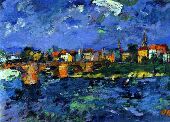
And then there are these:
The Red Egg which was painted in 1941.


Loreley, 1941

Alice in Wonderland, 1942
Above, London.View of the Tames from Shell-Mex House, 1959
And this poster for a play by Kokoschka, "Murderer, the Hope of Women."
By most accounts it was disturbing. 1909
Oskar Kokoschka was an Expressionist. He approached his work and his life experimentally at times. A lot of his portraits were oddly childlike but now and then he created a portrait that was powerful and once looked upon, could not be ignored or forgotten.
Portrait of a Girl, 1913

In 1915 he was seriously wounded in WWI and he was taken prisoner in Galicia. He suffered a head injury and his lung was pierced with a bayonet. He spent time recovering in Vienna and then he was sent to the Isonzo Front where he became ill. He went to Stockholm to see a brain specialist and then on to Dresden to try to recover. He struggled mentally and physically and as I read more about his life I think these were challenges he dealt with for decades.
I think it is interesting that he and Franz Marc, who was also a part of The Blue Rider Group, had suffered brain injuries in WWI. I also think it is interesting that many of the artists during that time found a refuge in Paris and that they traveled and their work remained true. I'm glad they had some time to meet like minded, free spirited artists. It must have been a special kind of nourishment that helped all of them survive the coming years.
And though he had become a celebrated artist in Vienna and in later in Germany and Paris too, by the time Mussolini and Hitler came into power, the whole scene had changed and he was considered a degenerate. So he split the scene there and after his mother passed away he skipped to Prague and became a Czech citizen. His ease would not last long. Germany was going to make a mess of it there and he could see it coming in 1938 so in 1939 he left for London. He didn't like it there. Probably for a lot of reasons. Poverty, rations, bombings. London was taking a direct hit and stood against fascism but it cost everyone there plenty.
He was uncomfortable and uninspired in London and in 1945, when the other great war that was supposed to end war was over; Kokoschka traveled and spent some time in Vienna. In Vienna he was honored for his work and I think this made him feel good about it. That somehow his work and he, when others of his friends did not, had survived not one but two world wars.
In his own words:
"What am I to do in this hole [their London flat] ? I must invent new subjects for my paintings. I am quite starved for something to see. When the spring comes I feel how it stirs in me as in a migrant bird, and I become quite nervous: I must leave town and paint something real - a grasshopper or something. When I come back to town the landscapes turn into political pictures. My heart aches, but I cannot help it. I cannot just paint landscapes without taking any notice of what happens."
Eventually, he settled in Villeneuve on Lake Geneva and stayed there for the rest of his life.
Self-portrait of Oskar Kokoschka.

There were times in Oskar Kokoshka's life that were flippin' bizarre. No doubt about it. He was so obsessed with Alma that after she left he had a lifelike doll of her made and took it to the opera. But through all of the experimentation and exploration of a world that intrigued and confounded him, he took care of his family and managed to survive and maybe even find peace.
I've been there myself. I painted this one after my brain injury at a time when it was still incredibly difficult to write or have a complete thought. When the pain to stand at the easel was so excruciating I could only handle it for short periods of time. And all of the questions that had plagued me for years hid like ghosts in the inbetween emptiness of my mind.
This one is called, "Quiet Desperation."
I don't think we can look back on our lives and say, well, as long as there was a happy ending it turned out all right. Because the scars of war or failed love or trauma or man's inhumanity toward everything; lingers in the recesses of our mind. What we remember and how we process it all becomes an indelible part of who we are. But that he found his way through and continued to work and create - that is beautiful. And that is Oskar Kokoschka.

No comments:
Post a Comment